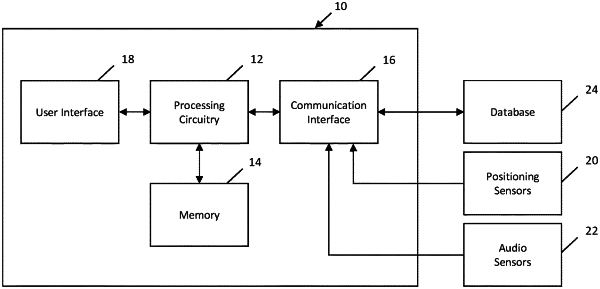| CPC G01C 21/3822 (2020.08) [G01C 21/30 (2013.01); G01C 21/3691 (2013.01); G01C 21/3848 (2020.08); G06N 20/00 (2019.01); H04R 3/005 (2013.01)] | 10 Claims |

|
1. An apparatus configured to predict a map object in real time based at least in part on audio data, the apparatus comprising at least one processor and at least one memory storing computer program code, the at least one memory and the computer program code configured to, with the processor, cause the apparatus to at least:
obtain the audio data created by a plurality of vehicles while driving over a road surface and interacting with a map object and an indication of a speed of the plurality of vehicles, wherein the audio data comprises one or more audio amplitude features and is obtained by one or more audio sensors, wherein the one or more audio amplitude features represent a change in amplitude relative to a noise floor, the noise floor determined based at least in part upon the speed of each respective vehicles;
obtain a class of each of the plurality of vehicles driving over the road surface;
provide the audio data including the one or more audio amplitude features, the speed of each respective vehicle, class of each vehicle driving over the road surface, and the map object interacted with by each vehicle to train a plurality of machine learning models;
provide additional data from one or more vehicles not included in the plurality of vehicles, wherein the additional data includes audio data including one or more audio amplitude features, speed of the one or more vehicles, and class of the one or more vehicles driving over a road surface to determine which of the plurality of machine learning models predicts the map object that creates the audio data with the greatest accuracy; and
predict in real time an unknown map object that created audio data while the additional vehicle interacted therewith utilizing the most accurate trained machine learning model, wherein the prediction is based upon at least audio data, the class of the additional vehicle, and the speed of the additional vehicle.
|